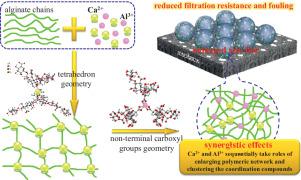Water Research ( IF 11.4 ) Pub Date : 2020-11-27 , DOI: 10.1016/j.watres.2020.116665 Ying Long , Genying Yu , Lu Dong , Yanchao Xu , Hongjun Lin , Ying Deng , Xiujia You , Lining Yang , Biao-Qiang Liao

|
Effects of calcium ions and polyaluminum chloride (PACl) on membrane fouling in coagulation-ultrafiltration (UF) process were investigated in this study. Filtration tests demonstrated three interesting filtration behaviors: 1) high specific filtration resistance (SFR) of alginate solution with low CaCl2 or PACl addition (e. g. 3.51×1015 m·kg -1 under the condition of 1.5 mM CaCl2 addition); 2) unimodal pattern of alginate SFR with PACl or CaCl2 addition alone; 3) synergistic effects between CaCl2 and PACl on alginate SFR. It was found that, the foulant morphological changes driven by the thermodynamic mechanisms based on Flory-Huggins lattice theory take the critical roles in these filtration behaviors. Density functional theory (DFT) calculations showed that initial coordination of Ca2+ and Al3+ ions with alginates tended to form tetrahedron geometry and geometry of coordinating three terminal carboxyl groups, respectively, which facilitated to elongate the alginate chains (without clustering the flocs) and form more stable gel, increasing SFR. Improving Ca2+ and Al3+ dosages triggered transition to other geometries for clustering polymeric network and flocculation, reducing SFR. Due to the higher binding affinity of Ca2+ over Al3+, Ca2+ and Al3+ sequentially take roles of enlarging polymeric network and clustering the coordination compounds, and then facilitate to form large size flocs and reduce SFR, causing the synergistic effects between CaCl2 and PACl additions. The proposed thermodynamic mechanisms satisfactorily explained these interesting fouling behaviors, allowing to further optimize coagulation-UF process.
中文翻译:

海藻酸钠溶液在超滤(UF)过程中钙离子和聚氯化铝协同结垢行为及机理
本研究研究了钙离子和聚氯化铝(PACl)对混凝-超滤(UF)过程中膜污染的影响。过滤测试显示出三种有趣的过滤行为:1)添加低CaCl 2或PACl的藻酸盐溶液的高比过滤阻力(SFR)(例如,在添加1.5 mM CaCl 2的条件下为3.51×10 15 m · kg -1);2)仅添加PACl或CaCl 2的藻酸盐SFR的单峰模式;3)CaCl 2之间的协同作用和藻酸盐SFR上的PACl。研究发现,基于Flory-Huggins晶格理论的热力学机制驱动的结垢形态变化在这些过滤行为中起着关键作用。密度泛函理论(DFT)计算表明,Ca 2+和Al 3+离子与藻酸盐的初始配位趋于分别形成四面体几何形状和配位三个末端羧基的几何形状,这有利于延长藻酸盐链(不使絮体成簇) )并形成更稳定的凝胶,从而增加SFR。Ca 2+和Al 3+剂量的增加触发了向其他几何形状的转变,从而使聚合物网络成簇并絮凝,从而降低了SFR。由于Ca具有更高的结合亲和力2+在Al 3+,钙2+和Al 3+依次采取扩大聚合物网络和聚类配位化合物的角色,然后促进以形成大尺寸的絮凝物和减少SFR,引起的CaCl之间的协同效应2和聚合铝添加。所提出的热力学机制令人满意地解释了这些有趣的结垢行为,从而可以进一步优化UF工艺。


















































 京公网安备 11010802027423号
京公网安备 11010802027423号